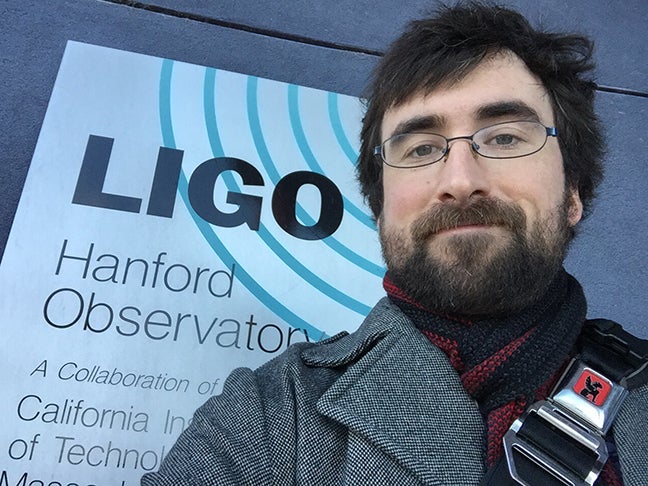KINGSTON, R.I., Oct. 19, 2017—It was written in the stars for Robert Coyne to be an astrophysicist.
The cosmos first charmed Coyne as a 5-year-old boy during long car rides at night on Cape Cod with his dad, an astronomy enthusiast who made black holes seem magical.
“I’d look at the night sky, and he’d tell me what was up there—what I could see and what I couldn’t,” says Coyne. “It just snowballed from there.”
This fall, Coyne joined the University of Rhode Island as a physics lecturer, and he expects to bring with him membership in an exclusive club: the Laser Interferometer Gravitational-Wave Observatory, or LIGO, whose founders won the Nobel Prize in physics earlier this month.
The international group of 1,200 scientists and technicians made headlines this week with the announcement that it had seen two neutron stars colliding 130 million light years away—heralding a new era in astronomy thanks, in part, to the detection of gravitational waves. Born from the explosive death of larger stars, neutron stars are city-sized stellar objects with at least the mass of the sun.
“I used to wonder what it might’ve been like to witness the invention of the telescope, to get a chance to experience, firsthand, a brand new way of observing the universe,” says Coyne, 32, now living in West Warwick. “I don’t have to wonder anymore.”
Historically, scientists have used light to study the cosmos. Now scientists are using fluctuations in gravity called gravitational waves, ripples in the fabric of space and time created when two objects spiral together and collide. It’s like having a new sense. Now, in addition to seeing the universe, it’s as if we can “hear” it too.
Gravitational waves were first predicted by Albert Einstein a century ago, but scientists thought they were too weak to be detected. After decades of effort, two LIGO detectors, in Livingston, La., and Hanford, Wash., were built to sense tiny fluctuations caused by these waves. Spearheaded by the California Institute of Technology and Massachusetts Institute of Technology, the LIGO Scientific Collaboration has grown into a worldwide effort and has partnered with other observatories, including the Europe-based Virgo detector and some 70 ground- and space-based observatories.
In 2015, a ripple produced by the merger of two black holes was “heard’’ by LIGO, and since then three more pairs of black holes have been detected, says Coyne. But the recent observation of two merging neutron stars—also seen with telescopes—is particularly significant because it marks the first time scientists have detected gravitational waves and light from the same event, he says.
“We can learn a lot from observing something with gravitational waves, and we can learn a lot from observing something with light,” says Coyne. “We can learn a lot more when we observe with both. This multi-messenger astronomy is the future of how we will unlock the universe’s greatest mysteries.”
By the time Coyne arrived at Bourne High School his knowledge of physics was impressive, but it was actually an English teacher who nurtured his love for the field.
“She was one of those teachers who had unbridled enthusiasm for engaging students in their interests,” says Coyne. “She taught me how to be creative, which is crucial to a successful scientist. A good scientist knows how to think outside the box.”
He studied physics at the University of Massachusetts, Dartmouth, and went on to get his doctorate, also in physics, at The George Washington University. He wrote his dissertation on gamma-ray bursts—the explosion from two neutron stars smashing into each other—and the gravitational waves that might come from them.
He joined LIGO in 2013 under the umbrella of his advisor’s research group and continued with the collaboration while he was at Texas Tech University doing post-doctoral work. As a member of the LIGO Scientific Collaboration, he has carved out a niche for himself as a data analyst and “archivist” responsible for tracking gamma-ray bursts. He hopes to continue his membership at URI.
“LIGO is an enormous group of scientists all interested in a common goal—doing astronomy with gravitational waves,” he says. “Joining isn’t as easy as just signing up. To become a member, I had to show that I’m doing important work for the collaboration.”
Coyne says observing the recent astronomical event in gravitational waves and light is exciting because it will help scientists learn more about the expanding universe, the composition of neutron stars, the origin of heavy elements like gold and silver, and the cause of some gamma-ray bursts.
“It might be tempting to call this a once-in-a-lifetime opportunity,” says Coyne. “But the greatest thing about this discovery is that it’s not once-in-a-lifetime; it is the first of many. Multi-messenger astronomy is just getting started, and just look at the cosmic mysteries we’re already starting to unravel with only one event. Imagine what we’ll learn once we’ve seen 10, or 100, or 1,000. We’ll find answers to questions we haven’t even thought to ask yet.”
One of Coyne’s goals at URI is to get the public and non-scientists interested in science. In graduate school, he helped run astronomy nights at the National Mall in Washington, D.C., and he’s given many public talks. He also writes for social media, including Reddit’s “Ask Me Anything.”
“There’s a preconception that in order to get involved with science you have to have an advanced degree. You don’t,” says Coyne. “We have citizen science projects where people can get involved with our research. I think that’s so cool.”
As for his father, also named Robert, Coyne says he is one of his biggest fans.
“I don’t think he could be happier with how things turned out,” says Coyne. “He always had faith in me, and he always supported me.”
Coyne is grateful for his father’s inspiration. He dedicated his dissertation to his wife, Kristen, his mother, Becky—and Dad.
“He got choked up,” says Coyne. “That little kid asking questions about the sky is now answering them.”

